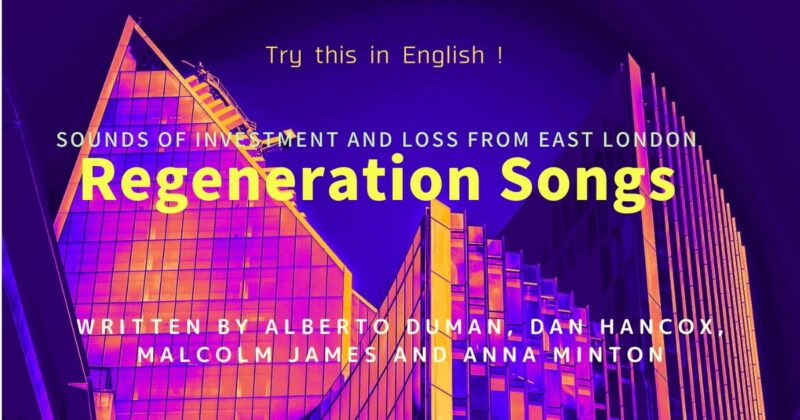Hello! It’s konkaz (@konkazuk) here.
This time, I am going to introduce a book about urban development in London.
In general, when people think of London, I believe the first images that come to mind for many are likely Buckingham Palace, Big Ben, Hyde Park, and so on – location situated westwards from the City of London, the central hub.
On the other hand, when it comes to the east, which was originally an industrial area, the image is quite different from the glamorous west. People might conjure up images of warehouses and shabby buildings, or, for some, no specific image at all.
However, if you’ve been living in East London for a while, you would undoubtedly feel the impact of the area’s development, particularly over the last 15 years. The momentum of local development is so impressive that you can sense it even without consciously paying attention.
…It’s simply tremendous.
When you revisit an area you haven’t been to for a year or two, it’s quite common to find out that the scenery has completely transformed.
So, the book I’m introducing here is about East London.
(As far as I know, there is no Japanese version of this book available at the moment.)
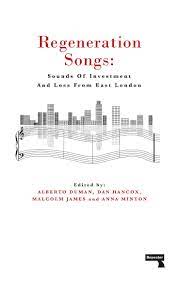
“Regeneration songs”
(Sounds Of Investment And Loss From East London)
written by Alberto Duman, Dan Hancox, Malcolm James and Anna Minton
This is a fascinating book that delves into the development of East London, particularly the areas north of the Thames River. It will tell you how the planning has unfolded and reveals the behind-the-scenes of it.

It’s also a fantastic book that, despite my initial indifference to local matters, swiftly brought me up to speed on the events, political backdrop, geography, and more in East London.
So, personally, I highly recommend this book.
Gentrification
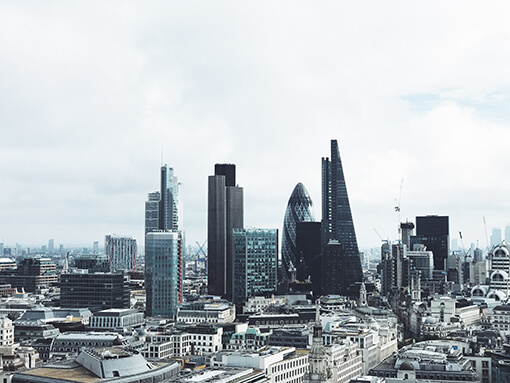
Gentrification
= the process of transforming neighborhoods or regions from low-value to high-value, often involving the influx of people from a higher social and economic class, resulting in changes such as increased property values, improved amenities, and shifts in the cultural and demographic makeup of the area.
Now, diving into the content of the book, the stage is set in an area east of the ‘City of London,’ and north of the Thames River, specifically within one of the seven ‘boroughs’ (similar to municipalities) called ‘Newham.’
Speaking of ‘Newham,’ it is known for ‘The Royal Docks,’ where the ‘City Airport‘ is situated. This airport was specifically constructed to allow business professionals working in the City of London to swiftly take off when needed.
In the northwestern part of ‘Newham,’ there is an area called ‘Stratford,’ which served as the stage for the 2012 London Olympics. And the area that covers from the “Stratford’ down in an arc shape to the southernmost part of ‘Newham’ – ‘The Royal Docks,’ it is referred to as the…
“Arc of Opportunity“.
And the narrative unfolds from the fact that…
this ‘Opportunity’ was not for the residents of ‘Newham’ but rather for overseas capitalists gathered at the Shanghai Expo.
There was this phrase,
‘London is moving east‘
being featured in a video titled as ‘London’s Regeneration SUPERNOVA’ at the Shanghai Expo, and it suggested that the center of London is shifting from west to east in the future, therefore it’s wise to invest in the ‘Newham’ area in the east now.
The gentrification of the area is progressing without consideration for the local community, as seen in this unilateral approach.
And as a justification for such actions, politicians reportedly say, “The public sector is already out of funds and unable to support new housing initiatives, so if we want to build new houses, we have to collaborate with the private sector, otherwise, it’s impossible.”
However, this is entirely untrue. In reality, as exemplified by the case of the Shanghai Expo mentioned earlier, the public sector actively attracts private developers and foreign investors for domestic investments by offering substantial subsidies and preferential tax treatments.

The plan to urbanize previously inexpensive industrial areas, incorporating developers to gain commercial profits, is also referred to as “Placemaking“. As a consequence of this development, rents tend to go up, leading to the displacement of the original residents.
The American author who advocates ‘Placemaking’ in his book titled as ‘The New Localism’ acknowledges that, in the end, this leads to the phenomenon of ‘resident turnover‘ where original residents are displaced.
At the end of the day, ‘Placemaking’ reduces the concept of a ‘community’ to a mere ‘commodity,’ where it becomes nothing more than a location for individuals with financial resources from abroad to invest in.
As a result, historic architectural landmarks in ’Newham’ from the late 1960s to early 1970s, such as the celebrated Modernist masterpieces like ‘Balfron Tower’ and ‘Robin Hood Gardens,’ have undergone significant transformations. Despite having housed numerous residents, these structures have been converted into luxury apartments, demolished, or replaced by new buildings, often driven by investments from overseas investors.
In the 1980s, the development plans for ‘The Royal Docks’ included ideas that took into consideration the local residents and community. However, by the early 21st century, these considerations were brushed aside, and the concept shifted to an investment area with business opportunities, aiming to become a development area of world-class urban quality.

As a person who has personally experienced the challenging process of Section 21 (the UK’s ‘eviction notice’), as detailed in the article here, I personally resonated with many aspects of the dialogue featured at the end of Part 2.
Of course, if you move out from the current residence to the outskirts, you will be able to live in a much larger space at a more affordable rent. However, what people seek depend on what they need, so while some may find happiness in such a move, there are also many who do not.
And still, the line “It’s better to move while you have the choice to move, rather than being forcibly relocated” conveys a sense of heaviness and reality when read in the context of the article.
Urban Development and Culture

The relationship between culture, such as art and music, and capitalism is also discussed here.
The book delves into how urban development utilizes culture, including art, and how external influences can change the role of art (nowadays it is required to be socially ‘useful’). These shifts create friction, and artists who cannot adapt to the pressure from the capitalist side may find themselves struggling.
The definition of ‘what is art’ evolves with the changing times. However, if artists cannot adapt their own ‘definition of art’ to these shifts, making a living becomes challenging.
Regarding music, the book features the vibrant “grime music” scene that was thriving in East London, particularly in the Stratford area, before urban development and the 2012 Olympics.
To be honest, I wasn’t very interested in this type of music, so I didn’t even know there was a genre called “grime”.

However, as someone who is interested in the East London accent, this experience has raised a desire to naturally understand the content sung by artists in this genre.
Incidentally, the reason why the term “grime,” which in Japanese means “dirt” or “dust,” was coined for this genre of music seems to be related to the poor living conditions of residents in East London, which was caused by the decline of industry in the area, leading to job losses and poverty.
In the book, the grime music artists express that…
‘Most grime tunes are made in a grimy council estate.’
‘Mum ain’t got enough money, everyone’s just angry… you need a tension release.’
Having a list of YouTube links in the book to view these ‘grime artists’ is a thoughtful addition.
I’ll include a video below for those who are interested. 👇
Furthermore, other than London, the book also delves into the post-punk and subsequent music scenes in the northwest of England, including Manchester and Sheffield (southwest Yorkshire). It explores the relationship between the music and the architectural styles of the backgrounds where this music originated.
Here as well, you can understand the progression of urban development/modernism assimilating the lives of the local residents and the frustration associated with it.
Particularly, it appears that the inorganic architectural styles built during that time due to development influenced the music styles of that era.
I was personally struck by the statement on page 221…
A modernism that committed itself to socially useful things – education, public housing, the National Health Service, rather than shopping and property speculation – is something to fight for.
So, it means that allowing the progress of modernism in places where the daily lives of ordinary citizens are not taken into consideration could result in hardships for the residents, doesn’t it?
The connection between music and modernist architecture is something I had never considered before. However, in the popular music born in the vicinity of Sheffield from the late 1970s onward, you can apparently hear a lot of that influence.
A Brief history of ‘The Royal Docks’ up to the present
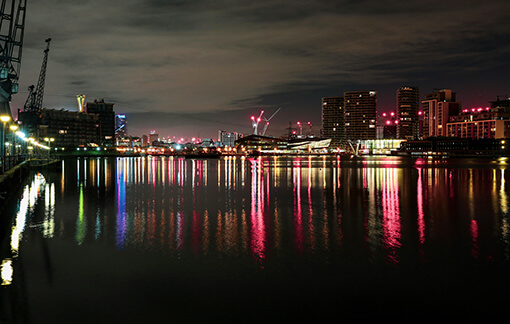
The Royal Docks, located in the southern part of Newham and developed throughout the 19th century, consist of three docks named…
Royal Victoria Dock,
Royal Albert Dock,
and
King George V Dock.
Docklands seemed to thrive until around the mid-20th century. However, with the invention of the intermodal container and its standardization in 1968, larger ships were built to transport them. Due to the size of these ships, the cargo handling eventually shifted to areas around the entrance of the Thames River, such as ‘Tilbury’ and ‘Gravesend’.
As a result, Docklands declined, many workers lost their jobs, and the industrial infrastructure of Docklands became derelict.
While it is a natural for the government and developers to focus on this area, there are residents and their communities in the region.
To resist the pressure from the London Docklands Development Corporation (LDDC), established in 1981 under the Conservative government, the local community teamed up with the Greater London Council and created the ‘People’s Plan for the Royal Docks.’ However, it ultimately did not succeed.
Despite various plans put forth by the developers, there was little progress on their side as well.
In 1988, City Airport was opened, but those arriving here tend to proceed directly to their destinations, turning the Royal Docks into a mere transit point.
To boost up the area’s economy, the Royal Docks must become a destination where people choose to visit.
For this to happen, attractions like hotels and restaurants need to be developed to encourage passengers arriving at the airport to stay in the area. However, the development of these attractions often comes at the expense of the local community.
the ArcelorMittal Orbit
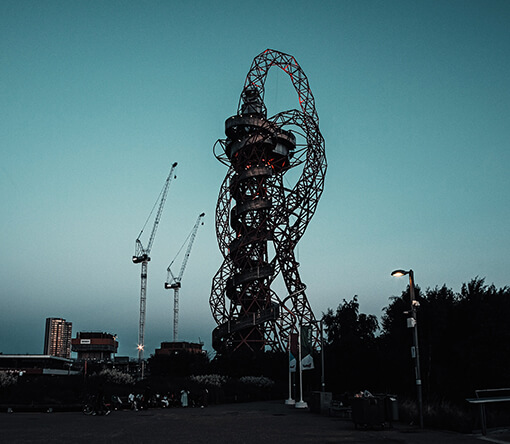
The ‘ArcelorMittal Orbit,’ towering over the Olympic Park in Stratford, is a massive sculpture created by two artists, Anish Kapoor and Cecil Balmond.
The name ‘ArcelorMittal’ includes the name of the sponsor, Mittal Steel (the world’s largest steel company), which sponsored the construction of the sculpture.
In fact, this company Mittal is known for its quite appalling practices, including environmental destruction such as air pollution, rule violations, and disregard for human rights. With connections to governmental powers in over 60 countries, as well as links to private financial institutions worldwide, the company seems to wield its influence to act as it pleases.
It is likely that the artists were aware of the nature of the sponsor company, but if they had refused, they might not have received the necessary materials. Additionally, passing up the opportunity to create a sculpture of this scale for a major event could mean missing out on a chance for further acclaim. So, in the end, they might have chosen not to refuse the offer.
By the way, actions where companies prioritize the expansion of their businesses, even at the expense of the environment and the lives of residents in large-scale areas, as seen in the example of Mittal, are referred to as “ecocide.”
🔹ecocide
= the mass destruction of nature by humans
Already dealt as a crime in Vietnam, Russia, Kyrgyzstan, Kazakhstan, Tajikistan, Belarus, Georgia, Ukraine, Moldova, Armenia, and France, the inclusion of ecocide as a crime is being considered in 27 countries, including EU member states.
Anyway, it’s painfully clear that behind the developments, not only in London but in many places, the sacrifice of local residents and the simultaneous destruction of their communities are occurring.
In Conclusion

What I thought after reading this book is that, fundamentally, events like urban development are just someone else’s affairs until they actually happen in the area where you live.
When something new is built in a certain area, for people living outside of it, the usual reaction is like, “Oh, something new is there. Maybe I should check it out?” without even considering what might be happening behind the scenes.
However, understanding such circumstances becomes the key to knowing what is happening behind the scenes in society, and it serves as training to get information about events occurring in your own area at an early stage.
Therefore, for those interested in what is happening behind urban development, not just in London but in general, you can purchase this book from the link below. 👇
Well, this is it. Thanks for reading till the end.
konkaz
You can read this blog post in Japanese from the link below.
👉 「都市開発の裏では何が起きているのか?」を英語で理解する!!! “Regeneration Songs”

